Evaluating Internet of Things
VerifiedAdded on 2023/01/23
|17
|3856
|27
AI Summary
This study examines the effects of IoT on automation and its impact on employment. It includes a literature review, research methodology, and business implications.
Contribute Materials
Your contribution can guide someone’s learning journey. Share your
documents today.
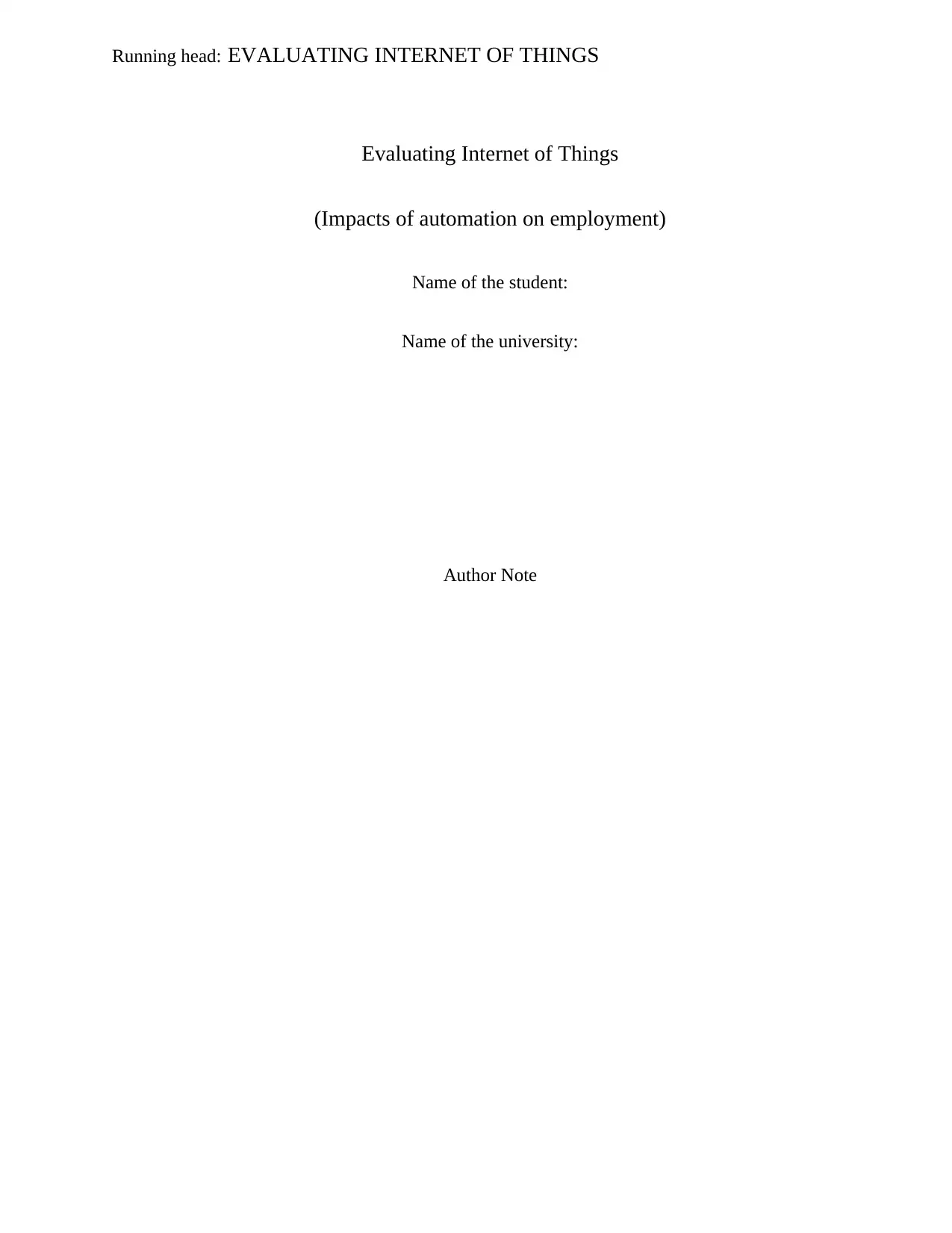
Running head: EVALUATING INTERNET OF THINGS
Evaluating Internet of Things
(Impacts of automation on employment)
Name of the student:
Name of the university:
Author Note
Evaluating Internet of Things
(Impacts of automation on employment)
Name of the student:
Name of the university:
Author Note
Secure Best Marks with AI Grader
Need help grading? Try our AI Grader for instant feedback on your assignments.
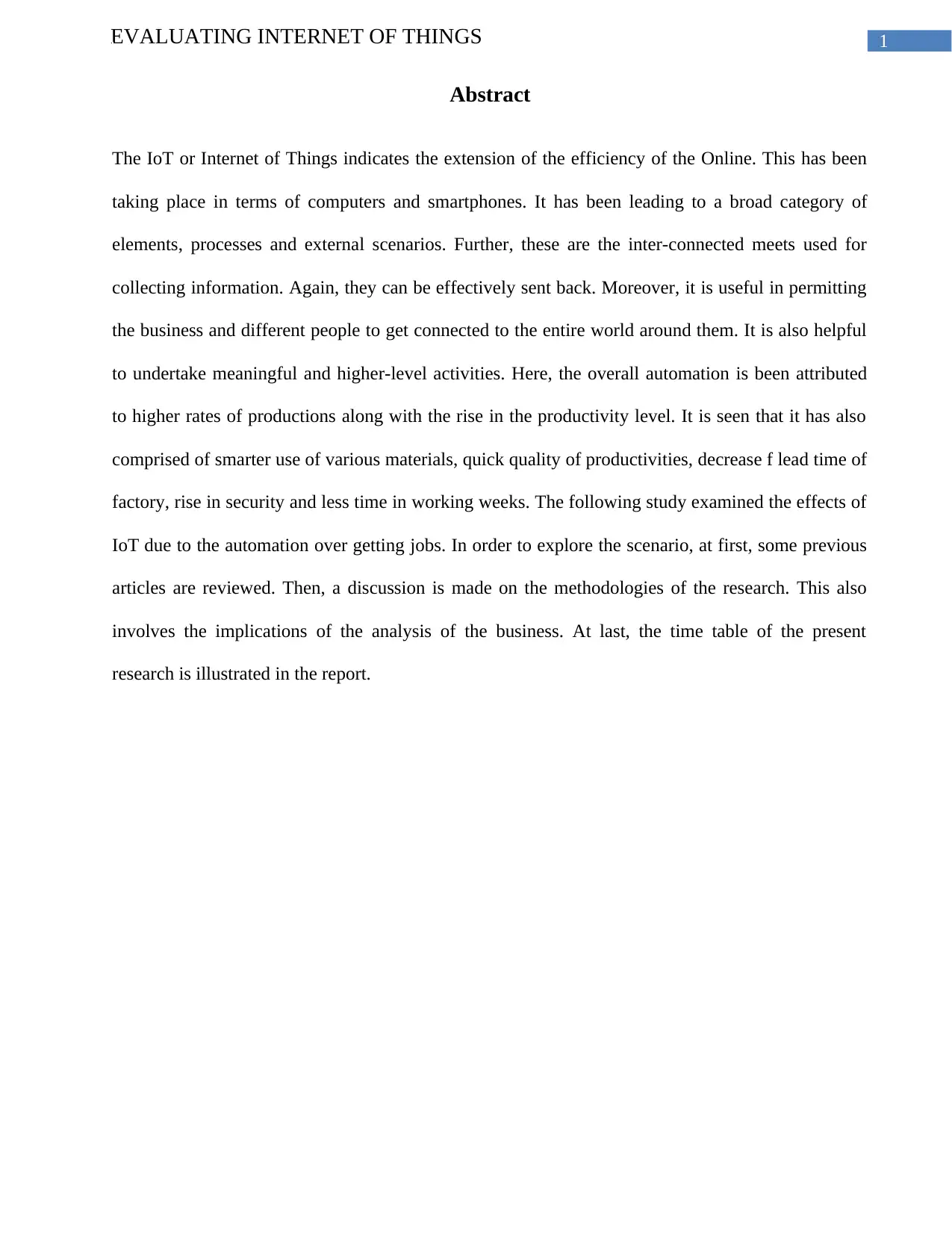
1EVALUATING INTERNET OF THINGS
Abstract
The IoT or Internet of Things indicates the extension of the efficiency of the Online. This has been
taking place in terms of computers and smartphones. It has been leading to a broad category of
elements, processes and external scenarios. Further, these are the inter-connected meets used for
collecting information. Again, they can be effectively sent back. Moreover, it is useful in permitting
the business and different people to get connected to the entire world around them. It is also helpful
to undertake meaningful and higher-level activities. Here, the overall automation is been attributed
to higher rates of productions along with the rise in the productivity level. It is seen that it has also
comprised of smarter use of various materials, quick quality of productivities, decrease f lead time of
factory, rise in security and less time in working weeks. The following study examined the effects of
IoT due to the automation over getting jobs. In order to explore the scenario, at first, some previous
articles are reviewed. Then, a discussion is made on the methodologies of the research. This also
involves the implications of the analysis of the business. At last, the time table of the present
research is illustrated in the report.
Abstract
The IoT or Internet of Things indicates the extension of the efficiency of the Online. This has been
taking place in terms of computers and smartphones. It has been leading to a broad category of
elements, processes and external scenarios. Further, these are the inter-connected meets used for
collecting information. Again, they can be effectively sent back. Moreover, it is useful in permitting
the business and different people to get connected to the entire world around them. It is also helpful
to undertake meaningful and higher-level activities. Here, the overall automation is been attributed
to higher rates of productions along with the rise in the productivity level. It is seen that it has also
comprised of smarter use of various materials, quick quality of productivities, decrease f lead time of
factory, rise in security and less time in working weeks. The following study examined the effects of
IoT due to the automation over getting jobs. In order to explore the scenario, at first, some previous
articles are reviewed. Then, a discussion is made on the methodologies of the research. This also
involves the implications of the analysis of the business. At last, the time table of the present
research is illustrated in the report.
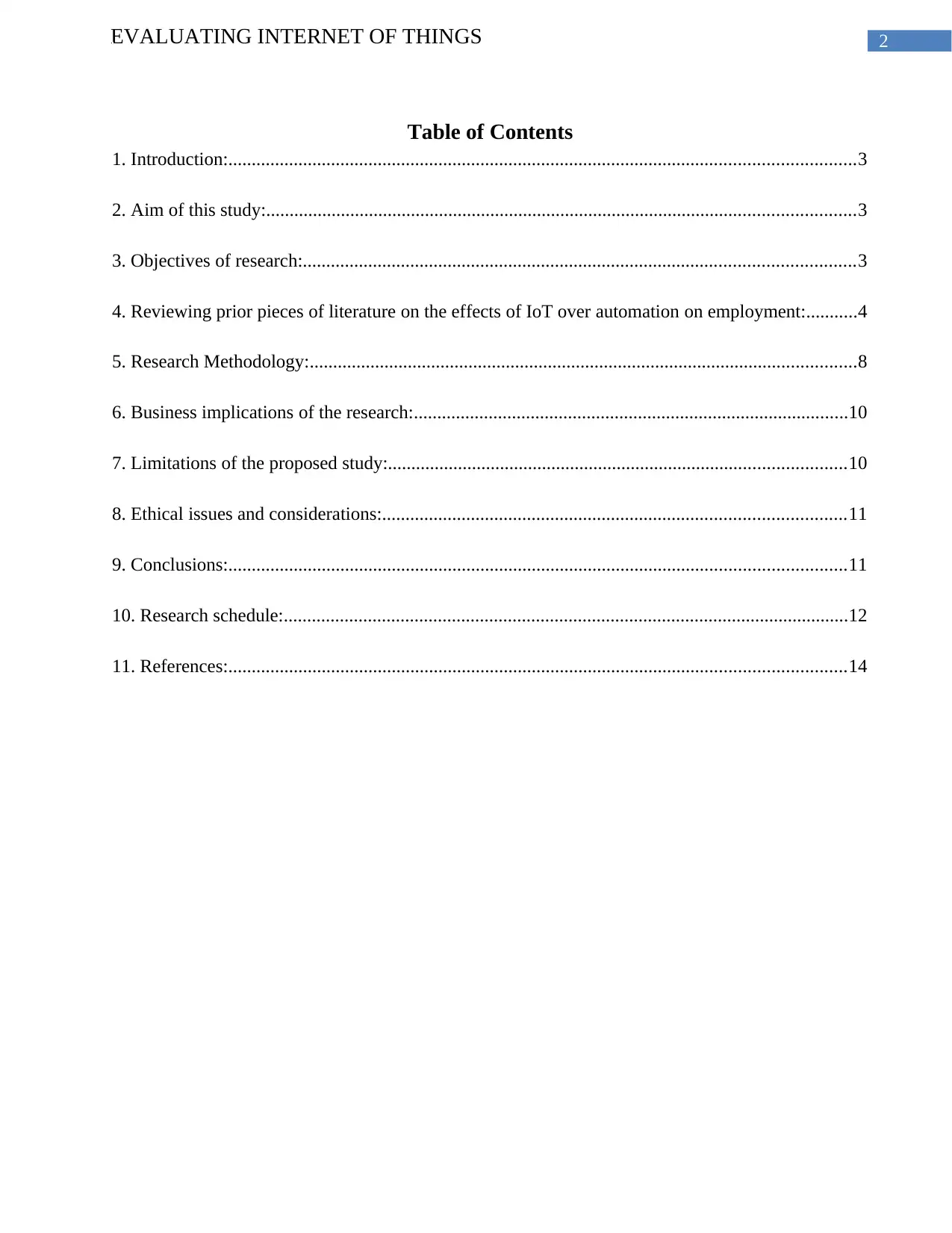
2EVALUATING INTERNET OF THINGS
Table of Contents
1. Introduction:......................................................................................................................................3
2. Aim of this study:..............................................................................................................................3
3. Objectives of research:......................................................................................................................3
4. Reviewing prior pieces of literature on the effects of IoT over automation on employment:...........4
5. Research Methodology:.....................................................................................................................8
6. Business implications of the research:.............................................................................................10
7. Limitations of the proposed study:..................................................................................................10
8. Ethical issues and considerations:...................................................................................................11
9. Conclusions:....................................................................................................................................11
10. Research schedule:.........................................................................................................................12
11. References:....................................................................................................................................14
Table of Contents
1. Introduction:......................................................................................................................................3
2. Aim of this study:..............................................................................................................................3
3. Objectives of research:......................................................................................................................3
4. Reviewing prior pieces of literature on the effects of IoT over automation on employment:...........4
5. Research Methodology:.....................................................................................................................8
6. Business implications of the research:.............................................................................................10
7. Limitations of the proposed study:..................................................................................................10
8. Ethical issues and considerations:...................................................................................................11
9. Conclusions:....................................................................................................................................11
10. Research schedule:.........................................................................................................................12
11. References:....................................................................................................................................14
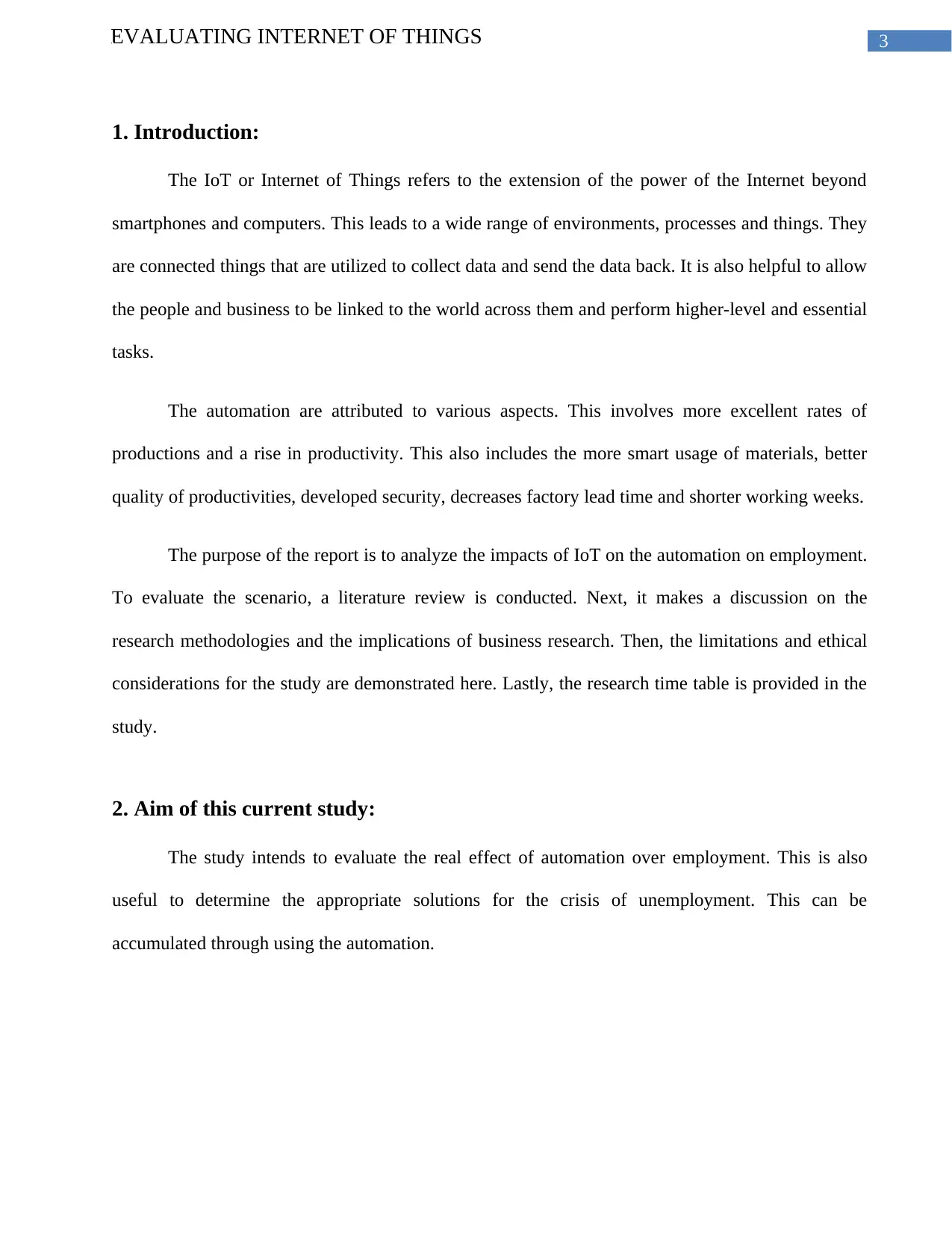
3EVALUATING INTERNET OF THINGS
1. Introduction:
The IoT or Internet of Things refers to the extension of the power of the Internet beyond
smartphones and computers. This leads to a wide range of environments, processes and things. They
are connected things that are utilized to collect data and send the data back. It is also helpful to allow
the people and business to be linked to the world across them and perform higher-level and essential
tasks.
The automation are attributed to various aspects. This involves more excellent rates of
productions and a rise in productivity. This also includes the more smart usage of materials, better
quality of productivities, developed security, decreases factory lead time and shorter working weeks.
The purpose of the report is to analyze the impacts of IoT on the automation on employment.
To evaluate the scenario, a literature review is conducted. Next, it makes a discussion on the
research methodologies and the implications of business research. Then, the limitations and ethical
considerations for the study are demonstrated here. Lastly, the research time table is provided in the
study.
2. Aim of this current study:
The study intends to evaluate the real effect of automation over employment. This is also
useful to determine the appropriate solutions for the crisis of unemployment. This can be
accumulated through using the automation.
1. Introduction:
The IoT or Internet of Things refers to the extension of the power of the Internet beyond
smartphones and computers. This leads to a wide range of environments, processes and things. They
are connected things that are utilized to collect data and send the data back. It is also helpful to allow
the people and business to be linked to the world across them and perform higher-level and essential
tasks.
The automation are attributed to various aspects. This involves more excellent rates of
productions and a rise in productivity. This also includes the more smart usage of materials, better
quality of productivities, developed security, decreases factory lead time and shorter working weeks.
The purpose of the report is to analyze the impacts of IoT on the automation on employment.
To evaluate the scenario, a literature review is conducted. Next, it makes a discussion on the
research methodologies and the implications of business research. Then, the limitations and ethical
considerations for the study are demonstrated here. Lastly, the research time table is provided in the
study.
2. Aim of this current study:
The study intends to evaluate the real effect of automation over employment. This is also
useful to determine the appropriate solutions for the crisis of unemployment. This can be
accumulated through using the automation.
Secure Best Marks with AI Grader
Need help grading? Try our AI Grader for instant feedback on your assignments.
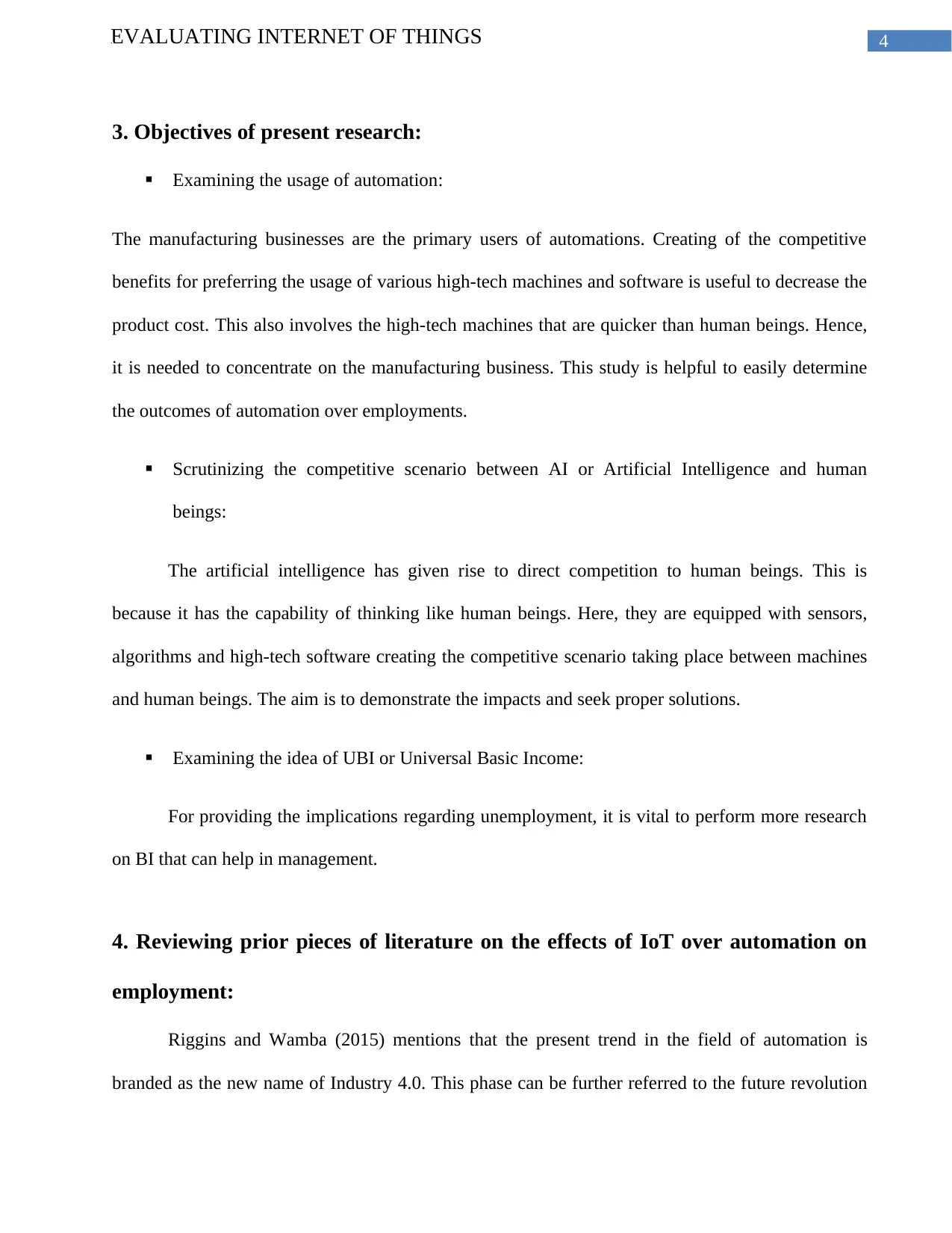
4EVALUATING INTERNET OF THINGS
3. Objectives of present research:
Examining the usage of automation:
The manufacturing businesses are the primary users of automations. Creating of the competitive
benefits for preferring the usage of various high-tech machines and software is useful to decrease the
product cost. This also involves the high-tech machines that are quicker than human beings. Hence,
it is needed to concentrate on the manufacturing business. This study is helpful to easily determine
the outcomes of automation over employments.
Scrutinizing the competitive scenario between AI or Artificial Intelligence and human
beings:
The artificial intelligence has given rise to direct competition to human beings. This is
because it has the capability of thinking like human beings. Here, they are equipped with sensors,
algorithms and high-tech software creating the competitive scenario taking place between machines
and human beings. The aim is to demonstrate the impacts and seek proper solutions.
Examining the idea of UBI or Universal Basic Income:
For providing the implications regarding unemployment, it is vital to perform more research
on BI that can help in management.
4. Reviewing prior pieces of literature on the effects of IoT over automation on
employment:
Riggins and Wamba (2015) mentions that the present trend in the field of automation is
branded as the new name of Industry 4.0. This phase can be further referred to the future revolution
3. Objectives of present research:
Examining the usage of automation:
The manufacturing businesses are the primary users of automations. Creating of the competitive
benefits for preferring the usage of various high-tech machines and software is useful to decrease the
product cost. This also involves the high-tech machines that are quicker than human beings. Hence,
it is needed to concentrate on the manufacturing business. This study is helpful to easily determine
the outcomes of automation over employments.
Scrutinizing the competitive scenario between AI or Artificial Intelligence and human
beings:
The artificial intelligence has given rise to direct competition to human beings. This is
because it has the capability of thinking like human beings. Here, they are equipped with sensors,
algorithms and high-tech software creating the competitive scenario taking place between machines
and human beings. The aim is to demonstrate the impacts and seek proper solutions.
Examining the idea of UBI or Universal Basic Income:
For providing the implications regarding unemployment, it is vital to perform more research
on BI that can help in management.
4. Reviewing prior pieces of literature on the effects of IoT over automation on
employment:
Riggins and Wamba (2015) mentions that the present trend in the field of automation is
branded as the new name of Industry 4.0. This phase can be further referred to the future revolution
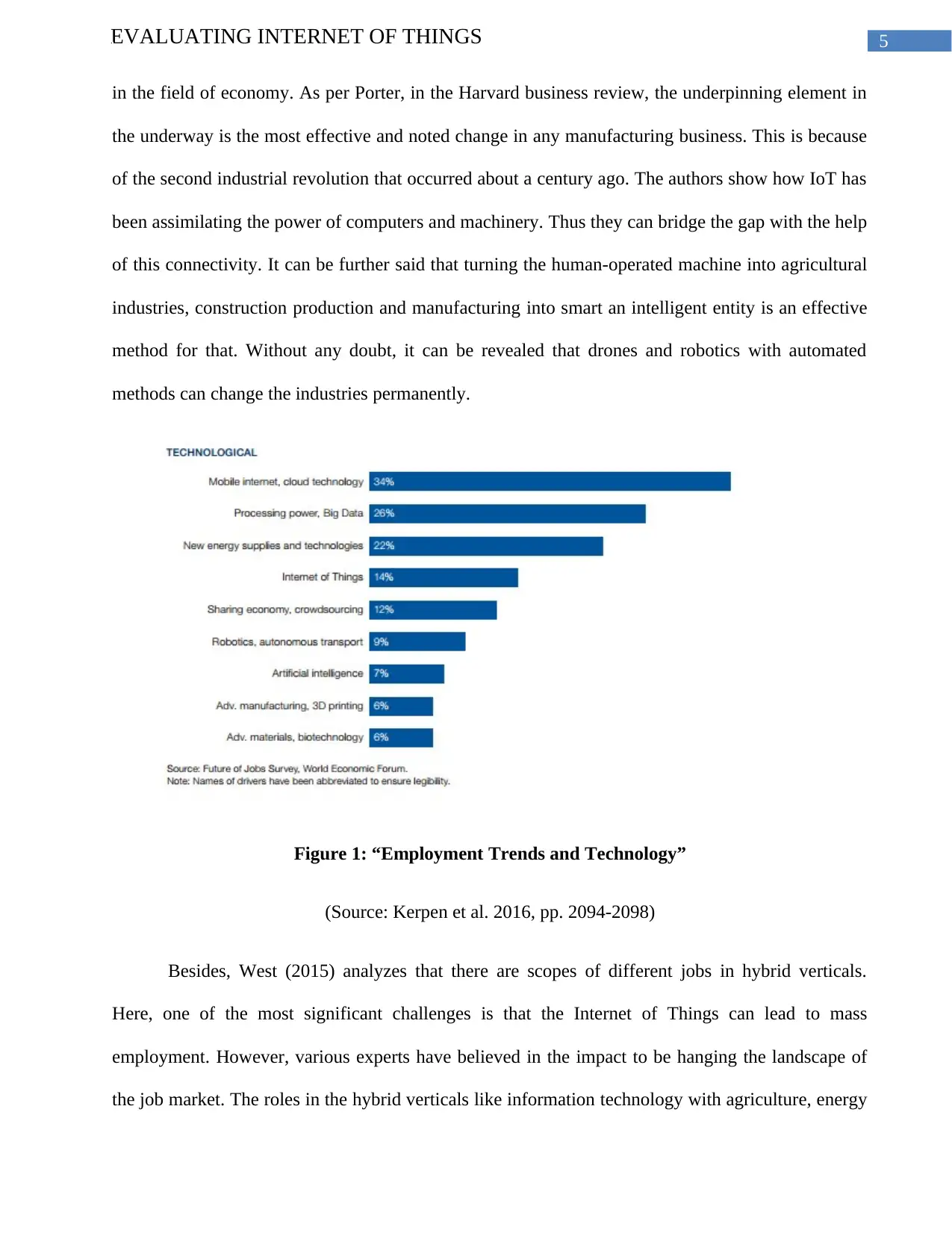
5EVALUATING INTERNET OF THINGS
in the field of economy. As per Porter, in the Harvard business review, the underpinning element in
the underway is the most effective and noted change in any manufacturing business. This is because
of the second industrial revolution that occurred about a century ago. The authors show how IoT has
been assimilating the power of computers and machinery. Thus they can bridge the gap with the help
of this connectivity. It can be further said that turning the human-operated machine into agricultural
industries, construction production and manufacturing into smart an intelligent entity is an effective
method for that. Without any doubt, it can be revealed that drones and robotics with automated
methods can change the industries permanently.
Figure 1: “Employment Trends and Technology”
(Source: Kerpen et al. 2016, pp. 2094-2098)
Besides, West (2015) analyzes that there are scopes of different jobs in hybrid verticals.
Here, one of the most significant challenges is that the Internet of Things can lead to mass
employment. However, various experts have believed in the impact to be hanging the landscape of
the job market. The roles in the hybrid verticals like information technology with agriculture, energy
in the field of economy. As per Porter, in the Harvard business review, the underpinning element in
the underway is the most effective and noted change in any manufacturing business. This is because
of the second industrial revolution that occurred about a century ago. The authors show how IoT has
been assimilating the power of computers and machinery. Thus they can bridge the gap with the help
of this connectivity. It can be further said that turning the human-operated machine into agricultural
industries, construction production and manufacturing into smart an intelligent entity is an effective
method for that. Without any doubt, it can be revealed that drones and robotics with automated
methods can change the industries permanently.
Figure 1: “Employment Trends and Technology”
(Source: Kerpen et al. 2016, pp. 2094-2098)
Besides, West (2015) analyzes that there are scopes of different jobs in hybrid verticals.
Here, one of the most significant challenges is that the Internet of Things can lead to mass
employment. However, various experts have believed in the impact to be hanging the landscape of
the job market. The roles in the hybrid verticals like information technology with agriculture, energy
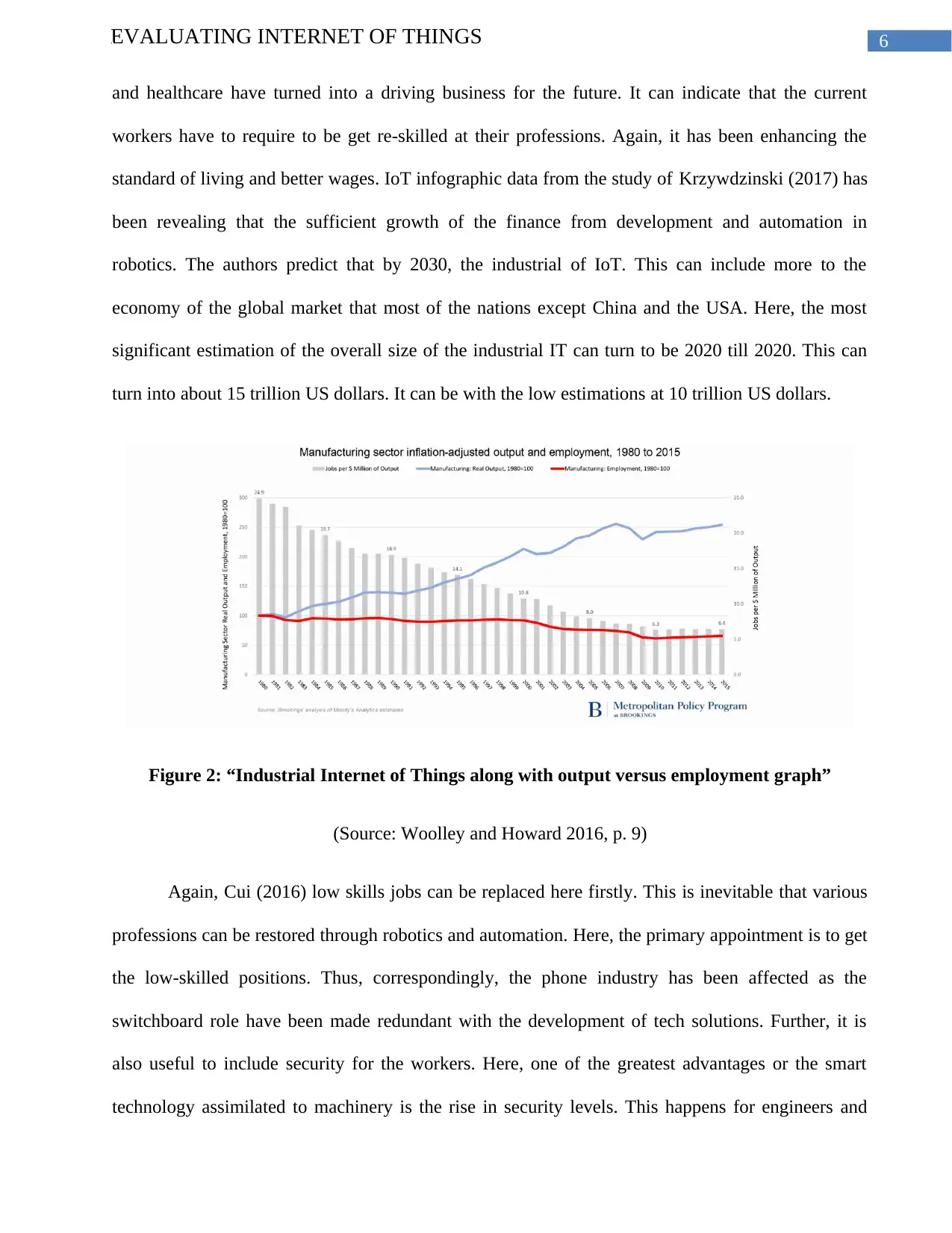
6EVALUATING INTERNET OF THINGS
and healthcare have turned into a driving business for the future. It can indicate that the current
workers have to require to be get re-skilled at their professions. Again, it has been enhancing the
standard of living and better wages. IoT infographic data from the study of Krzywdzinski (2017) has
been revealing that the sufficient growth of the finance from development and automation in
robotics. The authors predict that by 2030, the industrial of IoT. This can include more to the
economy of the global market that most of the nations except China and the USA. Here, the most
significant estimation of the overall size of the industrial IT can turn to be 2020 till 2020. This can
turn into about 15 trillion US dollars. It can be with the low estimations at 10 trillion US dollars.
Figure 2: “Industrial Internet of Things along with output versus employment graph”
(Source: Woolley and Howard 2016, p. 9)
Again, Cui (2016) low skills jobs can be replaced here firstly. This is inevitable that various
professions can be restored through robotics and automation. Here, the primary appointment is to get
the low-skilled positions. Thus, correspondingly, the phone industry has been affected as the
switchboard role have been made redundant with the development of tech solutions. Further, it is
also useful to include security for the workers. Here, one of the greatest advantages or the smart
technology assimilated to machinery is the rise in security levels. This happens for engineers and
and healthcare have turned into a driving business for the future. It can indicate that the current
workers have to require to be get re-skilled at their professions. Again, it has been enhancing the
standard of living and better wages. IoT infographic data from the study of Krzywdzinski (2017) has
been revealing that the sufficient growth of the finance from development and automation in
robotics. The authors predict that by 2030, the industrial of IoT. This can include more to the
economy of the global market that most of the nations except China and the USA. Here, the most
significant estimation of the overall size of the industrial IT can turn to be 2020 till 2020. This can
turn into about 15 trillion US dollars. It can be with the low estimations at 10 trillion US dollars.
Figure 2: “Industrial Internet of Things along with output versus employment graph”
(Source: Woolley and Howard 2016, p. 9)
Again, Cui (2016) low skills jobs can be replaced here firstly. This is inevitable that various
professions can be restored through robotics and automation. Here, the primary appointment is to get
the low-skilled positions. Thus, correspondingly, the phone industry has been affected as the
switchboard role have been made redundant with the development of tech solutions. Further, it is
also useful to include security for the workers. Here, one of the greatest advantages or the smart
technology assimilated to machinery is the rise in security levels. This happens for engineers and
Paraphrase This Document
Need a fresh take? Get an instant paraphrase of this document with our AI Paraphraser
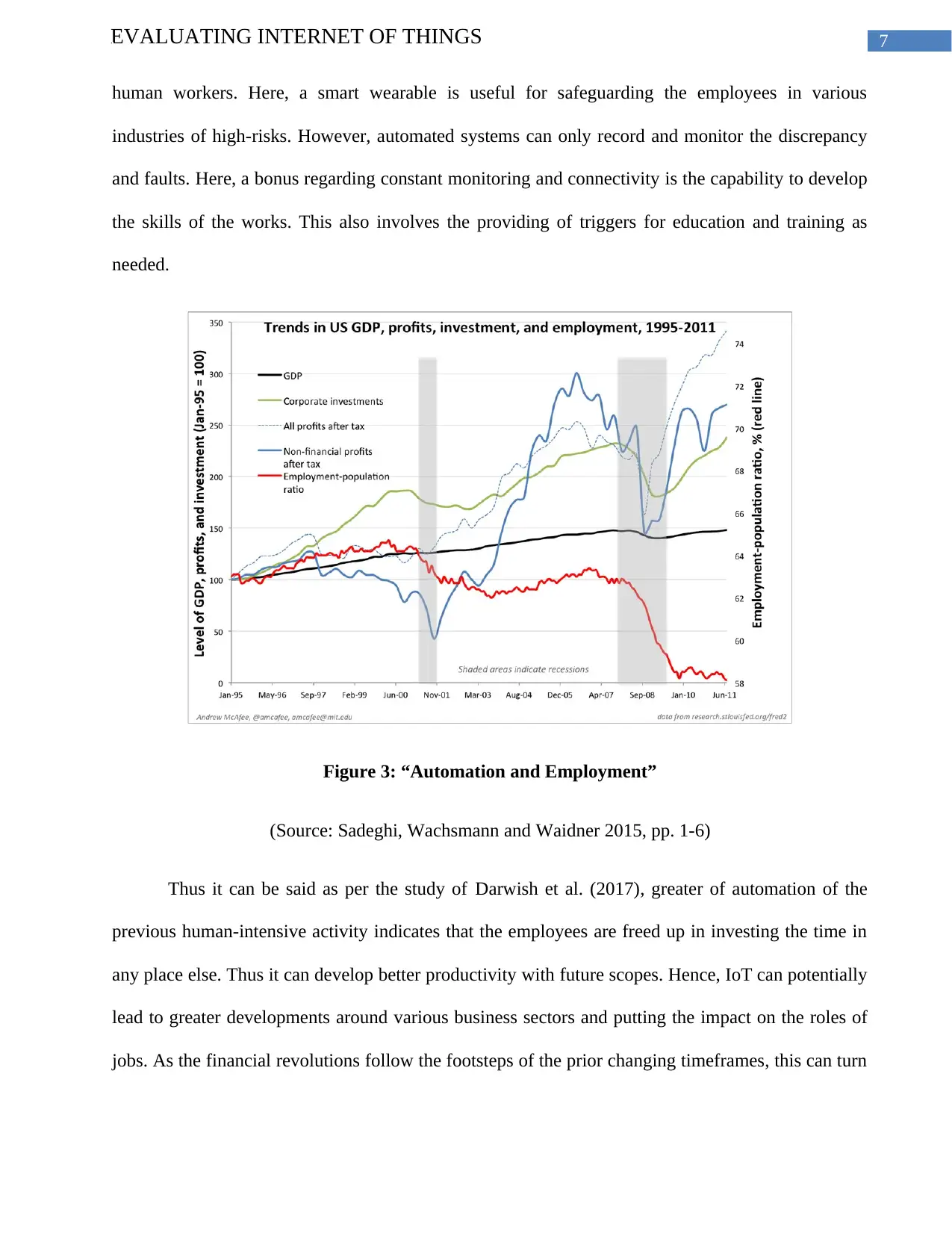
7EVALUATING INTERNET OF THINGS
human workers. Here, a smart wearable is useful for safeguarding the employees in various
industries of high-risks. However, automated systems can only record and monitor the discrepancy
and faults. Here, a bonus regarding constant monitoring and connectivity is the capability to develop
the skills of the works. This also involves the providing of triggers for education and training as
needed.
Figure 3: “Automation and Employment”
(Source: Sadeghi, Wachsmann and Waidner 2015, pp. 1-6)
Thus it can be said as per the study of Darwish et al. (2017), greater of automation of the
previous human-intensive activity indicates that the employees are freed up in investing the time in
any place else. Thus it can develop better productivity with future scopes. Hence, IoT can potentially
lead to greater developments around various business sectors and putting the impact on the roles of
jobs. As the financial revolutions follow the footsteps of the prior changing timeframes, this can turn
human workers. Here, a smart wearable is useful for safeguarding the employees in various
industries of high-risks. However, automated systems can only record and monitor the discrepancy
and faults. Here, a bonus regarding constant monitoring and connectivity is the capability to develop
the skills of the works. This also involves the providing of triggers for education and training as
needed.
Figure 3: “Automation and Employment”
(Source: Sadeghi, Wachsmann and Waidner 2015, pp. 1-6)
Thus it can be said as per the study of Darwish et al. (2017), greater of automation of the
previous human-intensive activity indicates that the employees are freed up in investing the time in
any place else. Thus it can develop better productivity with future scopes. Hence, IoT can potentially
lead to greater developments around various business sectors and putting the impact on the roles of
jobs. As the financial revolutions follow the footsteps of the prior changing timeframes, this can turn

8EVALUATING INTERNET OF THINGS
into a serious concern. Here, IoT can affect the prospects of jobs in an advantageous manner. Thus
they can embrace and adapt the latest scopes.
Figure 4: “OECD Policy Brief: Understanding the scenario of jobs that are at risk due
automation”
(Source: Nagy et al. 2018, p. 3491)
5. Research Methodology:
For this study, a survey is to be done on various individuals who suffered a loss of a job at
the U.K due to automation. Here, the questions must be included keeping the above objectives in
mind. The premises of the present inductive reasoning has been supporting the conclusion. Here, the
research begins through observation. It is helpful to analyze the usage of automation that has to
affect employment (Yaqoob et al. 2017).
Here, both quantitative and qualitative research strategies are used. The latter is used for
keeping the eye of human experiences and observations. This is performed through what the
employees have been thinking and what they have preferred to. Here, the qualitative research is
into a serious concern. Here, IoT can affect the prospects of jobs in an advantageous manner. Thus
they can embrace and adapt the latest scopes.
Figure 4: “OECD Policy Brief: Understanding the scenario of jobs that are at risk due
automation”
(Source: Nagy et al. 2018, p. 3491)
5. Research Methodology:
For this study, a survey is to be done on various individuals who suffered a loss of a job at
the U.K due to automation. Here, the questions must be included keeping the above objectives in
mind. The premises of the present inductive reasoning has been supporting the conclusion. Here, the
research begins through observation. It is helpful to analyze the usage of automation that has to
affect employment (Yaqoob et al. 2017).
Here, both quantitative and qualitative research strategies are used. The latter is used for
keeping the eye of human experiences and observations. This is performed through what the
employees have been thinking and what they have preferred to. Here, the qualitative research is
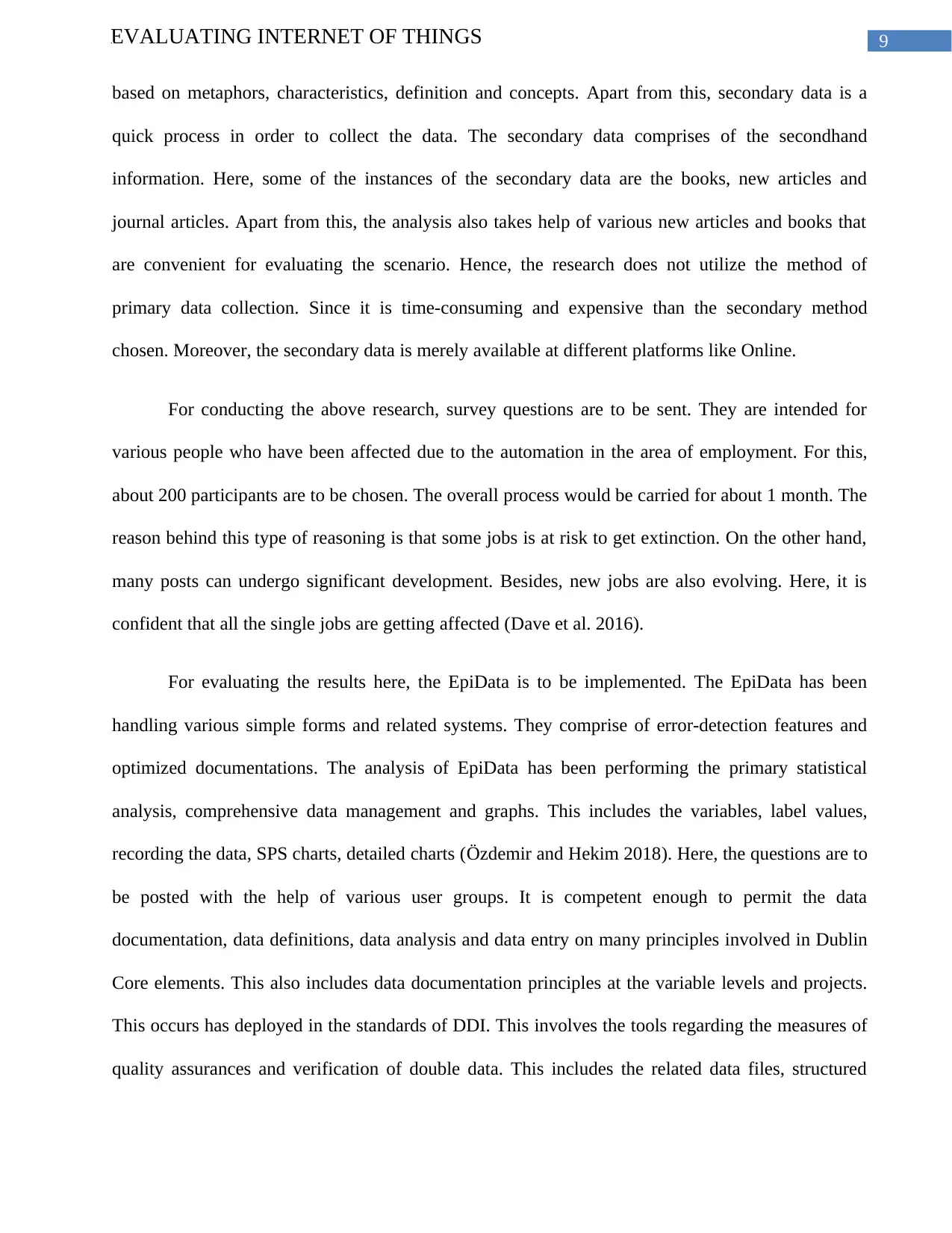
9EVALUATING INTERNET OF THINGS
based on metaphors, characteristics, definition and concepts. Apart from this, secondary data is a
quick process in order to collect the data. The secondary data comprises of the secondhand
information. Here, some of the instances of the secondary data are the books, new articles and
journal articles. Apart from this, the analysis also takes help of various new articles and books that
are convenient for evaluating the scenario. Hence, the research does not utilize the method of
primary data collection. Since it is time-consuming and expensive than the secondary method
chosen. Moreover, the secondary data is merely available at different platforms like Online.
For conducting the above research, survey questions are to be sent. They are intended for
various people who have been affected due to the automation in the area of employment. For this,
about 200 participants are to be chosen. The overall process would be carried for about 1 month. The
reason behind this type of reasoning is that some jobs is at risk to get extinction. On the other hand,
many posts can undergo significant development. Besides, new jobs are also evolving. Here, it is
confident that all the single jobs are getting affected (Dave et al. 2016).
For evaluating the results here, the EpiData is to be implemented. The EpiData has been
handling various simple forms and related systems. They comprise of error-detection features and
optimized documentations. The analysis of EpiData has been performing the primary statistical
analysis, comprehensive data management and graphs. This includes the variables, label values,
recording the data, SPS charts, detailed charts (Özdemir and Hekim 2018). Here, the questions are to
be posted with the help of various user groups. It is competent enough to permit the data
documentation, data definitions, data analysis and data entry on many principles involved in Dublin
Core elements. This also includes data documentation principles at the variable levels and projects.
This occurs has deployed in the standards of DDI. This involves the tools regarding the measures of
quality assurances and verification of double data. This includes the related data files, structured
based on metaphors, characteristics, definition and concepts. Apart from this, secondary data is a
quick process in order to collect the data. The secondary data comprises of the secondhand
information. Here, some of the instances of the secondary data are the books, new articles and
journal articles. Apart from this, the analysis also takes help of various new articles and books that
are convenient for evaluating the scenario. Hence, the research does not utilize the method of
primary data collection. Since it is time-consuming and expensive than the secondary method
chosen. Moreover, the secondary data is merely available at different platforms like Online.
For conducting the above research, survey questions are to be sent. They are intended for
various people who have been affected due to the automation in the area of employment. For this,
about 200 participants are to be chosen. The overall process would be carried for about 1 month. The
reason behind this type of reasoning is that some jobs is at risk to get extinction. On the other hand,
many posts can undergo significant development. Besides, new jobs are also evolving. Here, it is
confident that all the single jobs are getting affected (Dave et al. 2016).
For evaluating the results here, the EpiData is to be implemented. The EpiData has been
handling various simple forms and related systems. They comprise of error-detection features and
optimized documentations. The analysis of EpiData has been performing the primary statistical
analysis, comprehensive data management and graphs. This includes the variables, label values,
recording the data, SPS charts, detailed charts (Özdemir and Hekim 2018). Here, the questions are to
be posted with the help of various user groups. It is competent enough to permit the data
documentation, data definitions, data analysis and data entry on many principles involved in Dublin
Core elements. This also includes data documentation principles at the variable levels and projects.
This occurs has deployed in the standards of DDI. This involves the tools regarding the measures of
quality assurances and verification of double data. This includes the related data files, structured
Secure Best Marks with AI Grader
Need help grading? Try our AI Grader for instant feedback on your assignments.
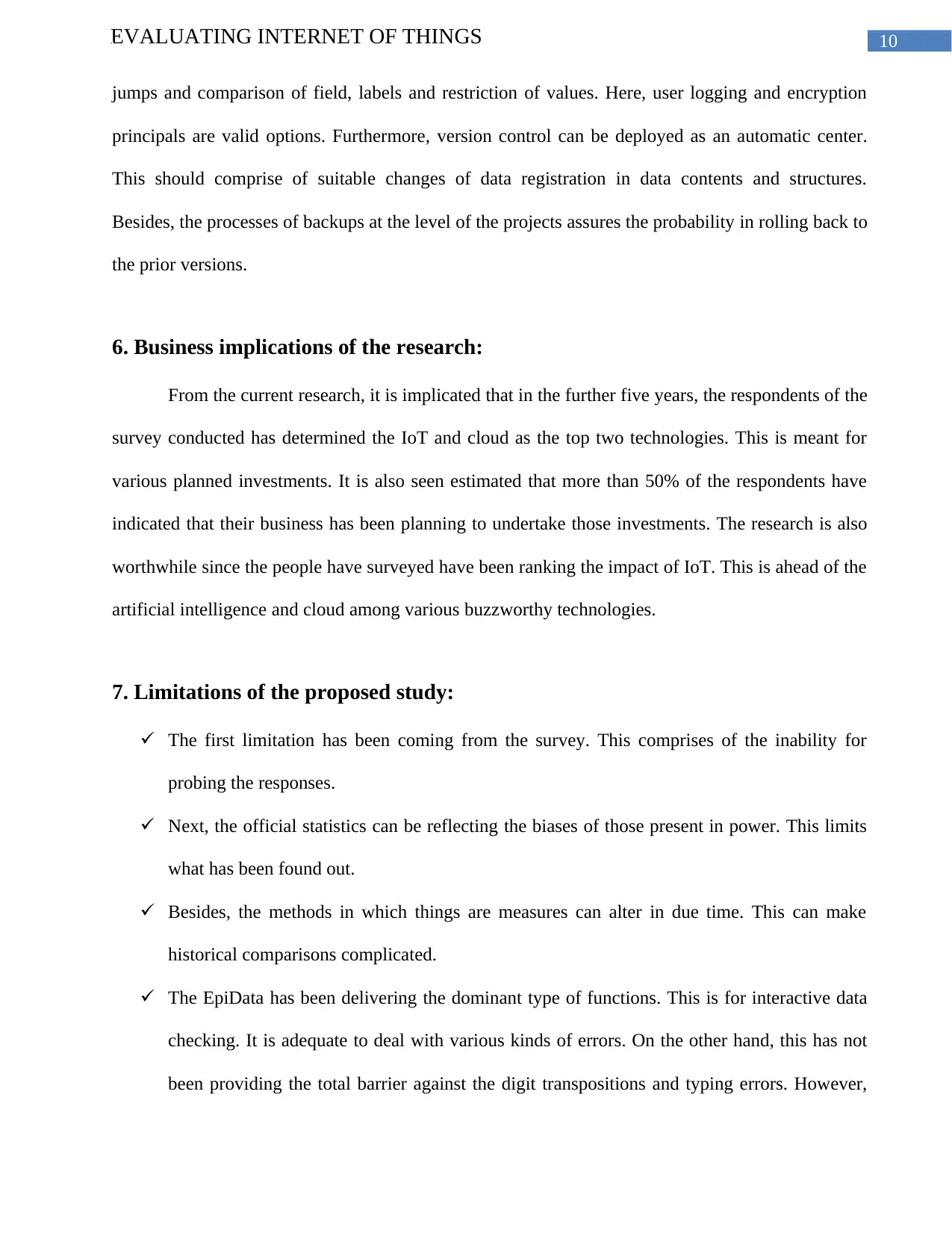
10EVALUATING INTERNET OF THINGS
jumps and comparison of field, labels and restriction of values. Here, user logging and encryption
principals are valid options. Furthermore, version control can be deployed as an automatic center.
This should comprise of suitable changes of data registration in data contents and structures.
Besides, the processes of backups at the level of the projects assures the probability in rolling back to
the prior versions.
6. Business implications of the research:
From the current research, it is implicated that in the further five years, the respondents of the
survey conducted has determined the IoT and cloud as the top two technologies. This is meant for
various planned investments. It is also seen estimated that more than 50% of the respondents have
indicated that their business has been planning to undertake those investments. The research is also
worthwhile since the people have surveyed have been ranking the impact of IoT. This is ahead of the
artificial intelligence and cloud among various buzzworthy technologies.
7. Limitations of the proposed study:
The first limitation has been coming from the survey. This comprises of the inability for
probing the responses.
Next, the official statistics can be reflecting the biases of those present in power. This limits
what has been found out.
Besides, the methods in which things are measures can alter in due time. This can make
historical comparisons complicated.
The EpiData has been delivering the dominant type of functions. This is for interactive data
checking. It is adequate to deal with various kinds of errors. On the other hand, this has not
been providing the total barrier against the digit transpositions and typing errors. However,
jumps and comparison of field, labels and restriction of values. Here, user logging and encryption
principals are valid options. Furthermore, version control can be deployed as an automatic center.
This should comprise of suitable changes of data registration in data contents and structures.
Besides, the processes of backups at the level of the projects assures the probability in rolling back to
the prior versions.
6. Business implications of the research:
From the current research, it is implicated that in the further five years, the respondents of the
survey conducted has determined the IoT and cloud as the top two technologies. This is meant for
various planned investments. It is also seen estimated that more than 50% of the respondents have
indicated that their business has been planning to undertake those investments. The research is also
worthwhile since the people have surveyed have been ranking the impact of IoT. This is ahead of the
artificial intelligence and cloud among various buzzworthy technologies.
7. Limitations of the proposed study:
The first limitation has been coming from the survey. This comprises of the inability for
probing the responses.
Next, the official statistics can be reflecting the biases of those present in power. This limits
what has been found out.
Besides, the methods in which things are measures can alter in due time. This can make
historical comparisons complicated.
The EpiData has been delivering the dominant type of functions. This is for interactive data
checking. It is adequate to deal with various kinds of errors. On the other hand, this has not
been providing the total barrier against the digit transpositions and typing errors. However,
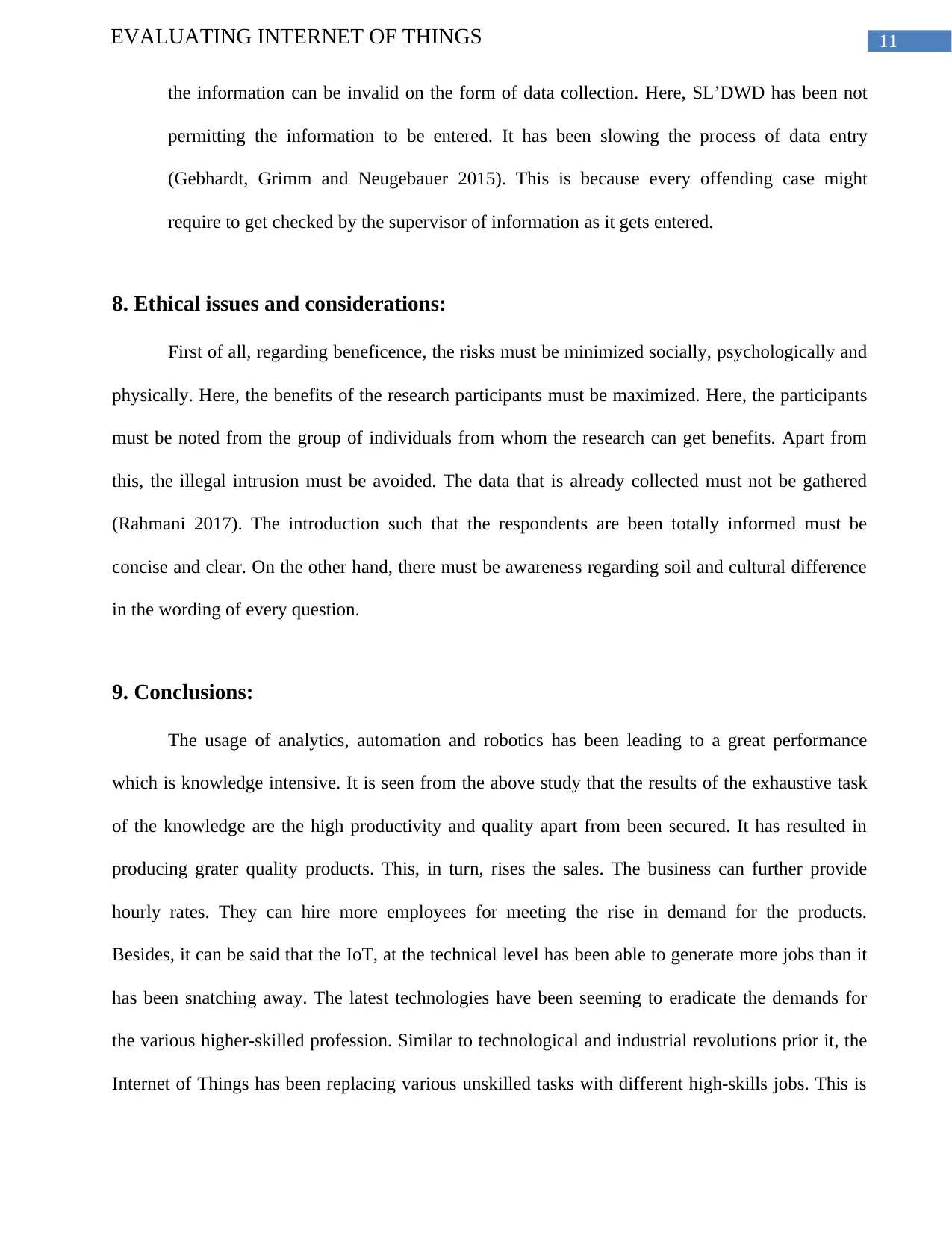
11EVALUATING INTERNET OF THINGS
the information can be invalid on the form of data collection. Here, SL’DWD has been not
permitting the information to be entered. It has been slowing the process of data entry
(Gebhardt, Grimm and Neugebauer 2015). This is because every offending case might
require to get checked by the supervisor of information as it gets entered.
8. Ethical issues and considerations:
First of all, regarding beneficence, the risks must be minimized socially, psychologically and
physically. Here, the benefits of the research participants must be maximized. Here, the participants
must be noted from the group of individuals from whom the research can get benefits. Apart from
this, the illegal intrusion must be avoided. The data that is already collected must not be gathered
(Rahmani 2017). The introduction such that the respondents are been totally informed must be
concise and clear. On the other hand, there must be awareness regarding soil and cultural difference
in the wording of every question.
9. Conclusions:
The usage of analytics, automation and robotics has been leading to a great performance
which is knowledge intensive. It is seen from the above study that the results of the exhaustive task
of the knowledge are the high productivity and quality apart from been secured. It has resulted in
producing grater quality products. This, in turn, rises the sales. The business can further provide
hourly rates. They can hire more employees for meeting the rise in demand for the products.
Besides, it can be said that the IoT, at the technical level has been able to generate more jobs than it
has been snatching away. The latest technologies have been seeming to eradicate the demands for
the various higher-skilled profession. Similar to technological and industrial revolutions prior it, the
Internet of Things has been replacing various unskilled tasks with different high-skills jobs. This is
the information can be invalid on the form of data collection. Here, SL’DWD has been not
permitting the information to be entered. It has been slowing the process of data entry
(Gebhardt, Grimm and Neugebauer 2015). This is because every offending case might
require to get checked by the supervisor of information as it gets entered.
8. Ethical issues and considerations:
First of all, regarding beneficence, the risks must be minimized socially, psychologically and
physically. Here, the benefits of the research participants must be maximized. Here, the participants
must be noted from the group of individuals from whom the research can get benefits. Apart from
this, the illegal intrusion must be avoided. The data that is already collected must not be gathered
(Rahmani 2017). The introduction such that the respondents are been totally informed must be
concise and clear. On the other hand, there must be awareness regarding soil and cultural difference
in the wording of every question.
9. Conclusions:
The usage of analytics, automation and robotics has been leading to a great performance
which is knowledge intensive. It is seen from the above study that the results of the exhaustive task
of the knowledge are the high productivity and quality apart from been secured. It has resulted in
producing grater quality products. This, in turn, rises the sales. The business can further provide
hourly rates. They can hire more employees for meeting the rise in demand for the products.
Besides, it can be said that the IoT, at the technical level has been able to generate more jobs than it
has been snatching away. The latest technologies have been seeming to eradicate the demands for
the various higher-skilled profession. Similar to technological and industrial revolutions prior it, the
Internet of Things has been replacing various unskilled tasks with different high-skills jobs. This is
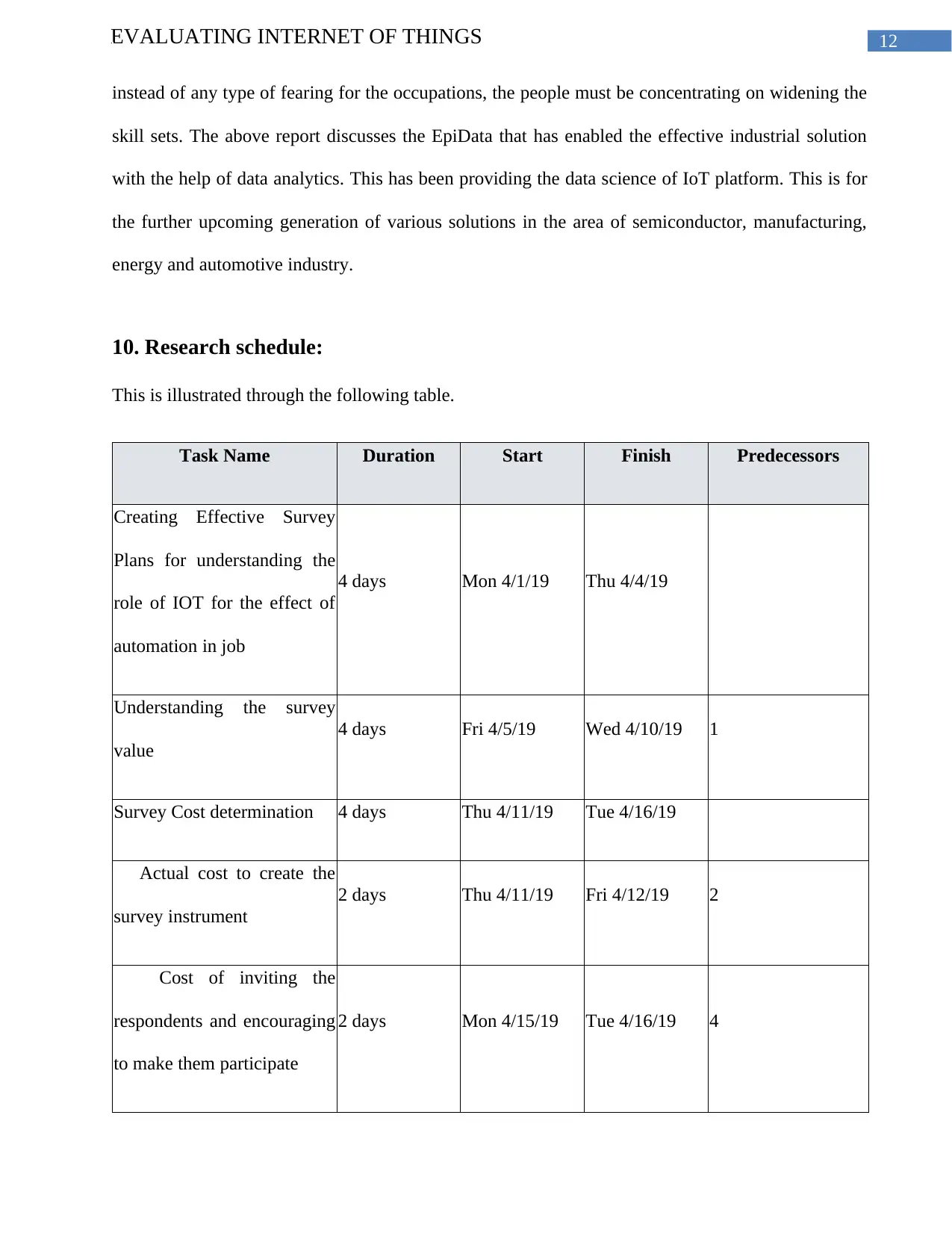
12EVALUATING INTERNET OF THINGS
instead of any type of fearing for the occupations, the people must be concentrating on widening the
skill sets. The above report discusses the EpiData that has enabled the effective industrial solution
with the help of data analytics. This has been providing the data science of IoT platform. This is for
the further upcoming generation of various solutions in the area of semiconductor, manufacturing,
energy and automotive industry.
10. Research schedule:
This is illustrated through the following table.
Task Name Duration Start Finish Predecessors
Creating Effective Survey
Plans for understanding the
role of IOT for the effect of
automation in job
4 days Mon 4/1/19 Thu 4/4/19
Understanding the survey
value
4 days Fri 4/5/19 Wed 4/10/19 1
Survey Cost determination 4 days Thu 4/11/19 Tue 4/16/19
Actual cost to create the
survey instrument
2 days Thu 4/11/19 Fri 4/12/19 2
Cost of inviting the
respondents and encouraging
to make them participate
2 days Mon 4/15/19 Tue 4/16/19 4
instead of any type of fearing for the occupations, the people must be concentrating on widening the
skill sets. The above report discusses the EpiData that has enabled the effective industrial solution
with the help of data analytics. This has been providing the data science of IoT platform. This is for
the further upcoming generation of various solutions in the area of semiconductor, manufacturing,
energy and automotive industry.
10. Research schedule:
This is illustrated through the following table.
Task Name Duration Start Finish Predecessors
Creating Effective Survey
Plans for understanding the
role of IOT for the effect of
automation in job
4 days Mon 4/1/19 Thu 4/4/19
Understanding the survey
value
4 days Fri 4/5/19 Wed 4/10/19 1
Survey Cost determination 4 days Thu 4/11/19 Tue 4/16/19
Actual cost to create the
survey instrument
2 days Thu 4/11/19 Fri 4/12/19 2
Cost of inviting the
respondents and encouraging
to make them participate
2 days Mon 4/15/19 Tue 4/16/19 4
Paraphrase This Document
Need a fresh take? Get an instant paraphrase of this document with our AI Paraphraser
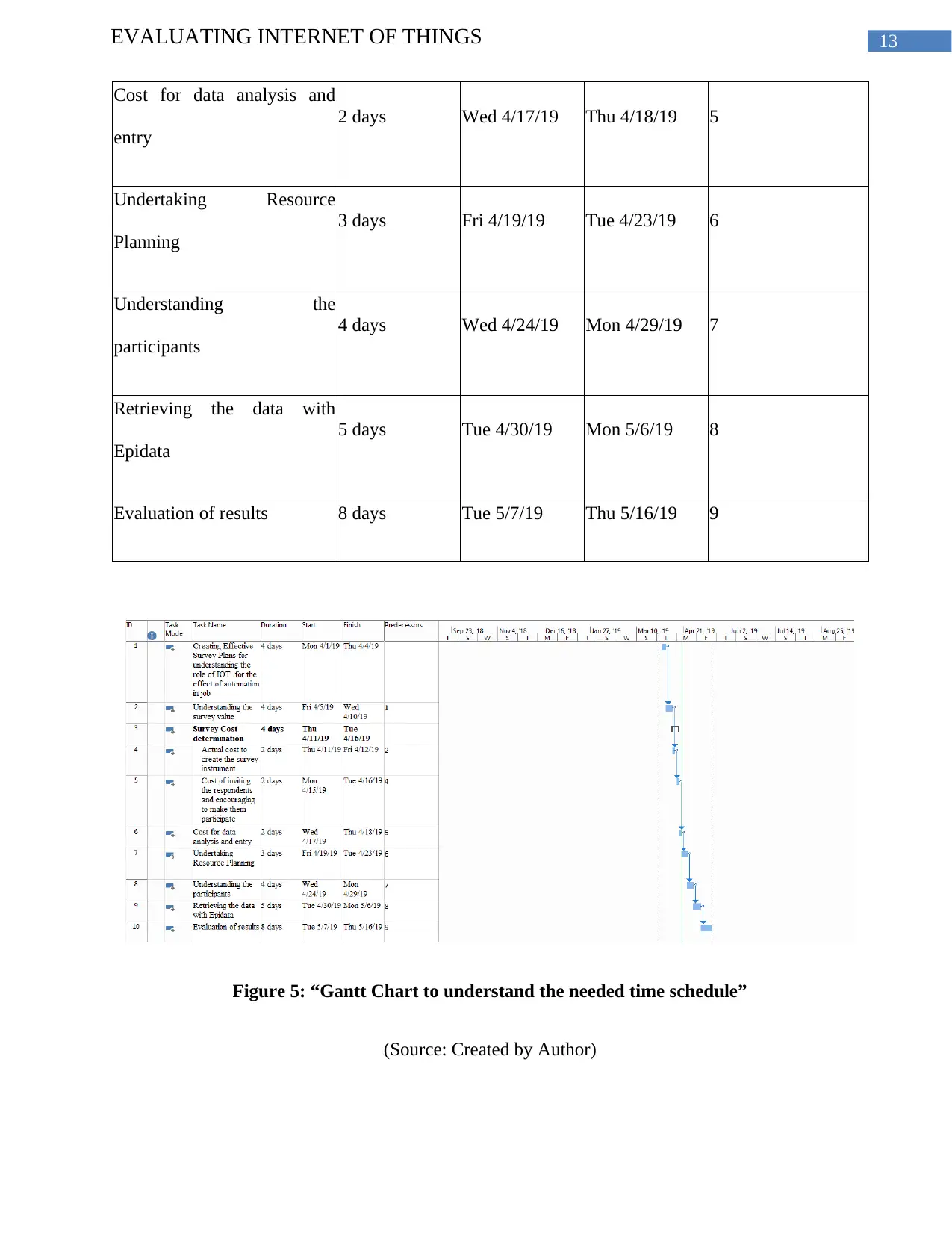
13EVALUATING INTERNET OF THINGS
Cost for data analysis and
entry
2 days Wed 4/17/19 Thu 4/18/19 5
Undertaking Resource
Planning
3 days Fri 4/19/19 Tue 4/23/19 6
Understanding the
participants
4 days Wed 4/24/19 Mon 4/29/19 7
Retrieving the data with
Epidata
5 days Tue 4/30/19 Mon 5/6/19 8
Evaluation of results 8 days Tue 5/7/19 Thu 5/16/19 9
Figure 5: “Gantt Chart to understand the needed time schedule”
(Source: Created by Author)
Cost for data analysis and
entry
2 days Wed 4/17/19 Thu 4/18/19 5
Undertaking Resource
Planning
3 days Fri 4/19/19 Tue 4/23/19 6
Understanding the
participants
4 days Wed 4/24/19 Mon 4/29/19 7
Retrieving the data with
Epidata
5 days Tue 4/30/19 Mon 5/6/19 8
Evaluation of results 8 days Tue 5/7/19 Thu 5/16/19 9
Figure 5: “Gantt Chart to understand the needed time schedule”
(Source: Created by Author)
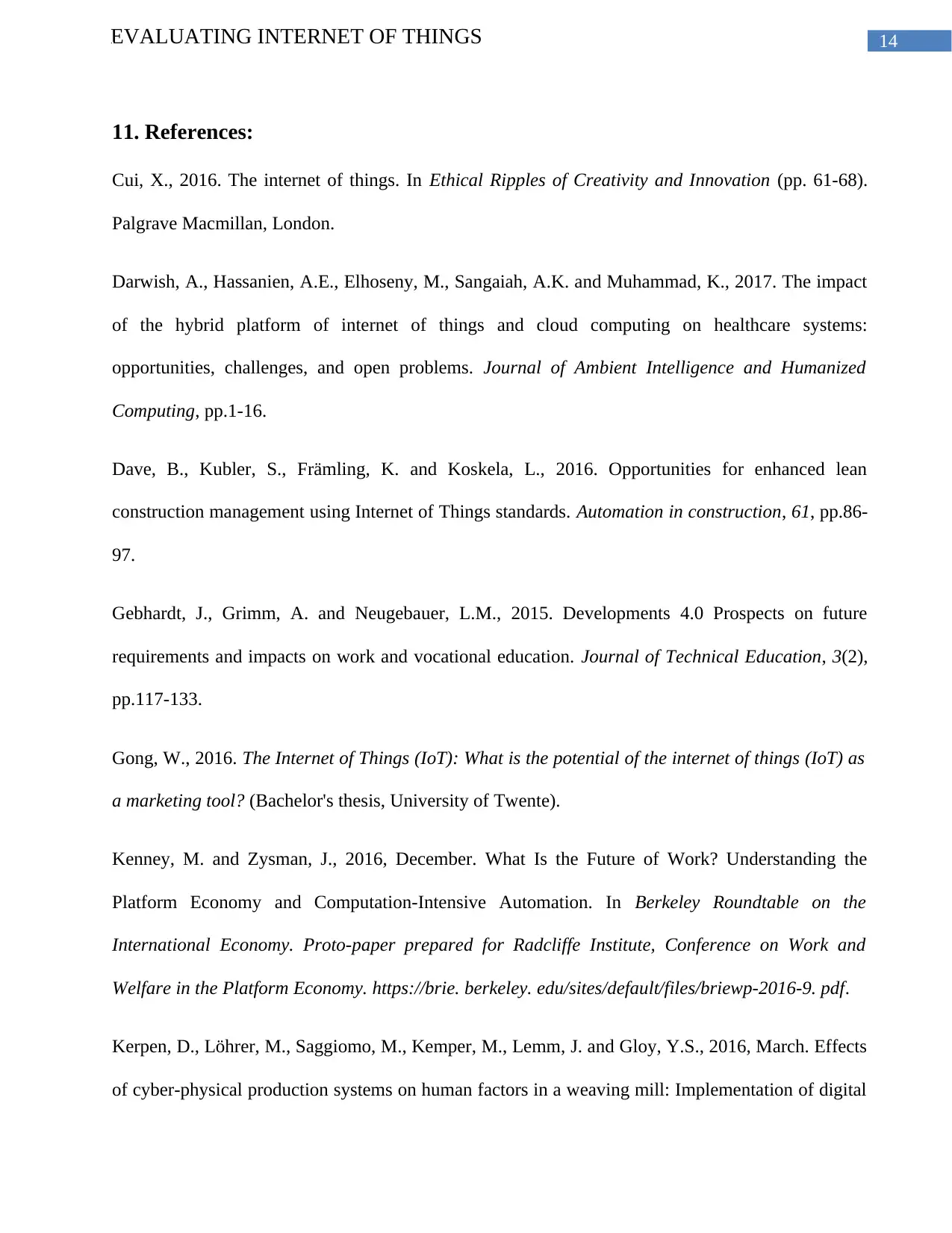
14EVALUATING INTERNET OF THINGS
11. References:
Cui, X., 2016. The internet of things. In Ethical Ripples of Creativity and Innovation (pp. 61-68).
Palgrave Macmillan, London.
Darwish, A., Hassanien, A.E., Elhoseny, M., Sangaiah, A.K. and Muhammad, K., 2017. The impact
of the hybrid platform of internet of things and cloud computing on healthcare systems:
opportunities, challenges, and open problems. Journal of Ambient Intelligence and Humanized
Computing, pp.1-16.
Dave, B., Kubler, S., Främling, K. and Koskela, L., 2016. Opportunities for enhanced lean
construction management using Internet of Things standards. Automation in construction, 61, pp.86-
97.
Gebhardt, J., Grimm, A. and Neugebauer, L.M., 2015. Developments 4.0 Prospects on future
requirements and impacts on work and vocational education. Journal of Technical Education, 3(2),
pp.117-133.
Gong, W., 2016. The Internet of Things (IoT): What is the potential of the internet of things (IoT) as
a marketing tool? (Bachelor's thesis, University of Twente).
Kenney, M. and Zysman, J., 2016, December. What Is the Future of Work? Understanding the
Platform Economy and Computation-Intensive Automation. In Berkeley Roundtable on the
International Economy. Proto-paper prepared for Radcliffe Institute, Conference on Work and
Welfare in the Platform Economy. https://brie. berkeley. edu/sites/default/files/briewp-2016-9. pdf.
Kerpen, D., Löhrer, M., Saggiomo, M., Kemper, M., Lemm, J. and Gloy, Y.S., 2016, March. Effects
of cyber-physical production systems on human factors in a weaving mill: Implementation of digital
11. References:
Cui, X., 2016. The internet of things. In Ethical Ripples of Creativity and Innovation (pp. 61-68).
Palgrave Macmillan, London.
Darwish, A., Hassanien, A.E., Elhoseny, M., Sangaiah, A.K. and Muhammad, K., 2017. The impact
of the hybrid platform of internet of things and cloud computing on healthcare systems:
opportunities, challenges, and open problems. Journal of Ambient Intelligence and Humanized
Computing, pp.1-16.
Dave, B., Kubler, S., Främling, K. and Koskela, L., 2016. Opportunities for enhanced lean
construction management using Internet of Things standards. Automation in construction, 61, pp.86-
97.
Gebhardt, J., Grimm, A. and Neugebauer, L.M., 2015. Developments 4.0 Prospects on future
requirements and impacts on work and vocational education. Journal of Technical Education, 3(2),
pp.117-133.
Gong, W., 2016. The Internet of Things (IoT): What is the potential of the internet of things (IoT) as
a marketing tool? (Bachelor's thesis, University of Twente).
Kenney, M. and Zysman, J., 2016, December. What Is the Future of Work? Understanding the
Platform Economy and Computation-Intensive Automation. In Berkeley Roundtable on the
International Economy. Proto-paper prepared for Radcliffe Institute, Conference on Work and
Welfare in the Platform Economy. https://brie. berkeley. edu/sites/default/files/briewp-2016-9. pdf.
Kerpen, D., Löhrer, M., Saggiomo, M., Kemper, M., Lemm, J. and Gloy, Y.S., 2016, March. Effects
of cyber-physical production systems on human factors in a weaving mill: Implementation of digital
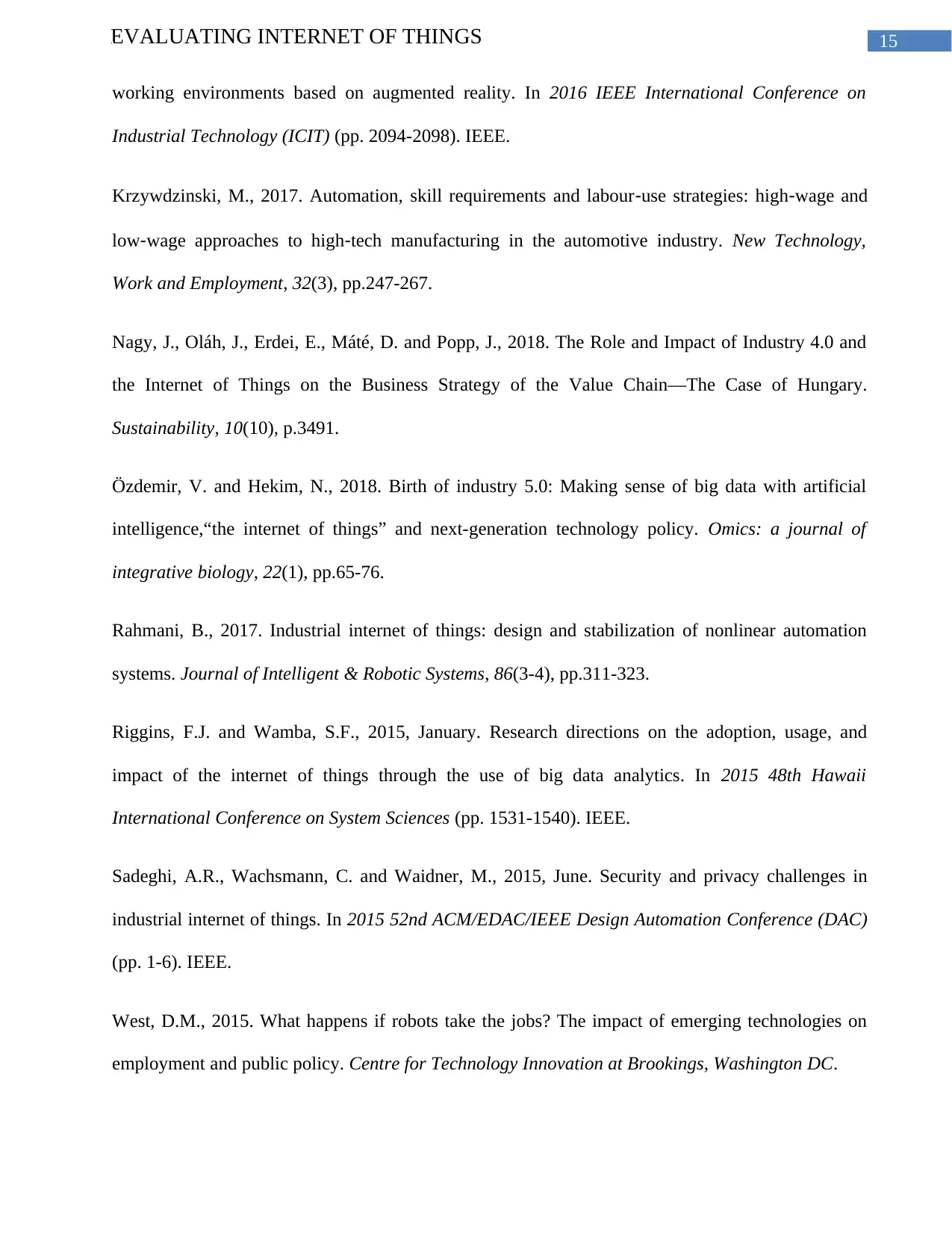
15EVALUATING INTERNET OF THINGS
working environments based on augmented reality. In 2016 IEEE International Conference on
Industrial Technology (ICIT) (pp. 2094-2098). IEEE.
Krzywdzinski, M., 2017. Automation, skill requirements and labour‐use strategies: high‐wage and
low‐wage approaches to high‐tech manufacturing in the automotive industry. New Technology,
Work and Employment, 32(3), pp.247-267.
Nagy, J., Oláh, J., Erdei, E., Máté, D. and Popp, J., 2018. The Role and Impact of Industry 4.0 and
the Internet of Things on the Business Strategy of the Value Chain—The Case of Hungary.
Sustainability, 10(10), p.3491.
Özdemir, V. and Hekim, N., 2018. Birth of industry 5.0: Making sense of big data with artificial
intelligence,“the internet of things” and next-generation technology policy. Omics: a journal of
integrative biology, 22(1), pp.65-76.
Rahmani, B., 2017. Industrial internet of things: design and stabilization of nonlinear automation
systems. Journal of Intelligent & Robotic Systems, 86(3-4), pp.311-323.
Riggins, F.J. and Wamba, S.F., 2015, January. Research directions on the adoption, usage, and
impact of the internet of things through the use of big data analytics. In 2015 48th Hawaii
International Conference on System Sciences (pp. 1531-1540). IEEE.
Sadeghi, A.R., Wachsmann, C. and Waidner, M., 2015, June. Security and privacy challenges in
industrial internet of things. In 2015 52nd ACM/EDAC/IEEE Design Automation Conference (DAC)
(pp. 1-6). IEEE.
West, D.M., 2015. What happens if robots take the jobs? The impact of emerging technologies on
employment and public policy. Centre for Technology Innovation at Brookings, Washington DC.
working environments based on augmented reality. In 2016 IEEE International Conference on
Industrial Technology (ICIT) (pp. 2094-2098). IEEE.
Krzywdzinski, M., 2017. Automation, skill requirements and labour‐use strategies: high‐wage and
low‐wage approaches to high‐tech manufacturing in the automotive industry. New Technology,
Work and Employment, 32(3), pp.247-267.
Nagy, J., Oláh, J., Erdei, E., Máté, D. and Popp, J., 2018. The Role and Impact of Industry 4.0 and
the Internet of Things on the Business Strategy of the Value Chain—The Case of Hungary.
Sustainability, 10(10), p.3491.
Özdemir, V. and Hekim, N., 2018. Birth of industry 5.0: Making sense of big data with artificial
intelligence,“the internet of things” and next-generation technology policy. Omics: a journal of
integrative biology, 22(1), pp.65-76.
Rahmani, B., 2017. Industrial internet of things: design and stabilization of nonlinear automation
systems. Journal of Intelligent & Robotic Systems, 86(3-4), pp.311-323.
Riggins, F.J. and Wamba, S.F., 2015, January. Research directions on the adoption, usage, and
impact of the internet of things through the use of big data analytics. In 2015 48th Hawaii
International Conference on System Sciences (pp. 1531-1540). IEEE.
Sadeghi, A.R., Wachsmann, C. and Waidner, M., 2015, June. Security and privacy challenges in
industrial internet of things. In 2015 52nd ACM/EDAC/IEEE Design Automation Conference (DAC)
(pp. 1-6). IEEE.
West, D.M., 2015. What happens if robots take the jobs? The impact of emerging technologies on
employment and public policy. Centre for Technology Innovation at Brookings, Washington DC.
Secure Best Marks with AI Grader
Need help grading? Try our AI Grader for instant feedback on your assignments.
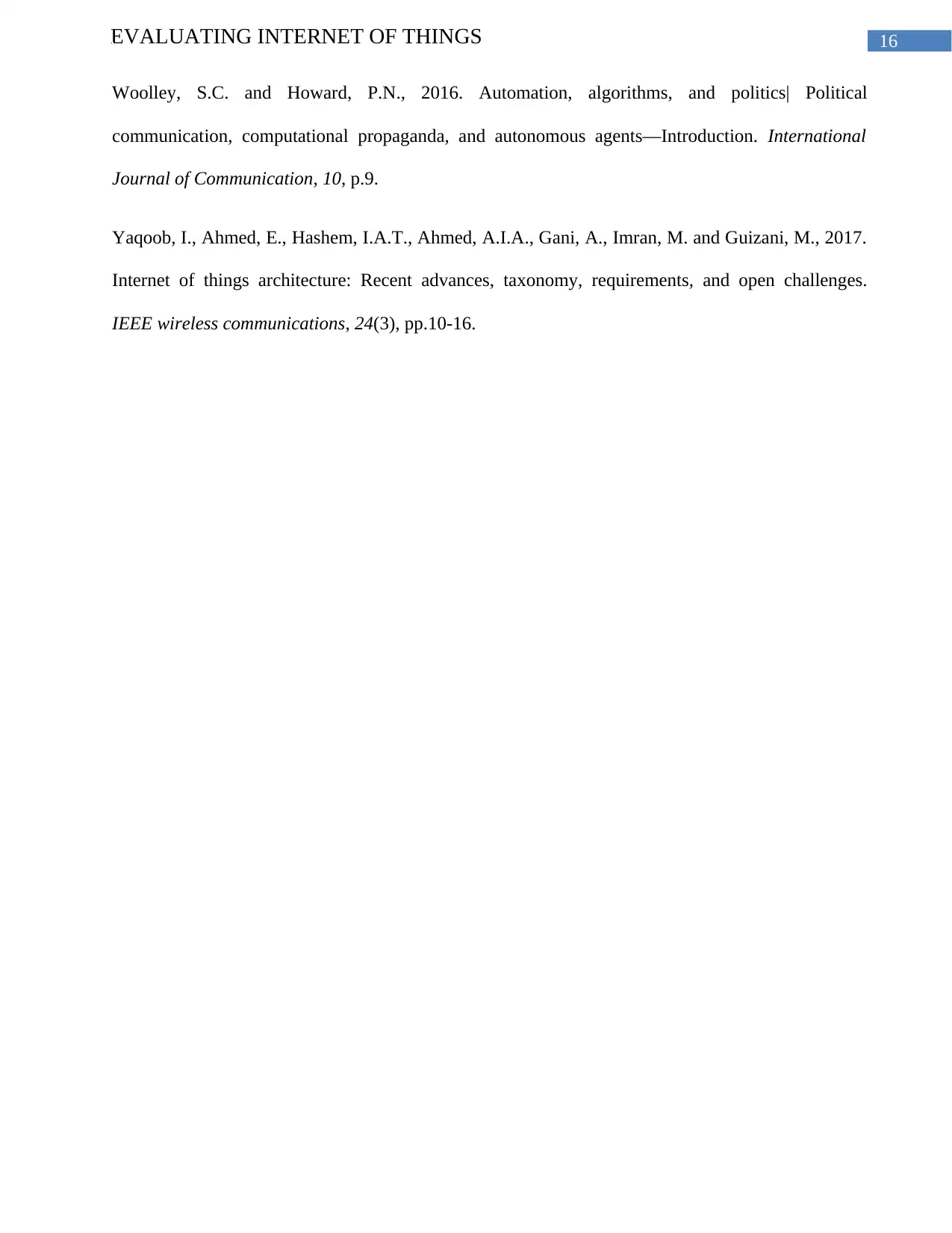
16EVALUATING INTERNET OF THINGS
Woolley, S.C. and Howard, P.N., 2016. Automation, algorithms, and politics| Political
communication, computational propaganda, and autonomous agents—Introduction. International
Journal of Communication, 10, p.9.
Yaqoob, I., Ahmed, E., Hashem, I.A.T., Ahmed, A.I.A., Gani, A., Imran, M. and Guizani, M., 2017.
Internet of things architecture: Recent advances, taxonomy, requirements, and open challenges.
IEEE wireless communications, 24(3), pp.10-16.
Woolley, S.C. and Howard, P.N., 2016. Automation, algorithms, and politics| Political
communication, computational propaganda, and autonomous agents—Introduction. International
Journal of Communication, 10, p.9.
Yaqoob, I., Ahmed, E., Hashem, I.A.T., Ahmed, A.I.A., Gani, A., Imran, M. and Guizani, M., 2017.
Internet of things architecture: Recent advances, taxonomy, requirements, and open challenges.
IEEE wireless communications, 24(3), pp.10-16.
1 out of 17
Related Documents
Your All-in-One AI-Powered Toolkit for Academic Success.
+13062052269
info@desklib.com
Available 24*7 on WhatsApp / Email
![[object Object]](/_next/static/media/star-bottom.7253800d.svg)
Unlock your academic potential
© 2024 | Zucol Services PVT LTD | All rights reserved.




